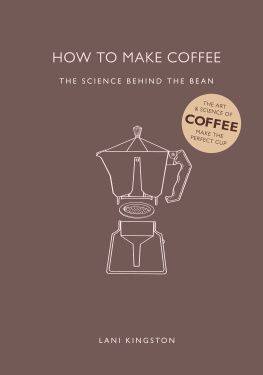INTRODUCTION

The morning cup of coffee has an exhilaration about it which the cheering influence of the afternoon or evening cup of tea cannot be expected to reproduce.
Oliver Wendell Holmes Sr.,
19th-century American physician and poet
Every day across the globe, approximately 1.6 billion cups of coffee are consumed. The United States alone is responsible for a quarter of that amount, and coffee is also the second most traded commodity in the world after oil. These are big stats and point to the tremendous role that coffee plays in our global economy. But as Ive traveled the world over the past decade, Ive also seen how important coffee is on the smallest, most human level.
Ive been welcomed into family kitchens in Tamil Nadu, India, and was taught how to prepare rich creamy South Indian filter coffee. Ive made new friends in some of Europes oldest coffeeshops in Vienna and Paris, and sipped tiny Styrofoam cups of tinto in Cartagena, Colombia, which I always bought from a roving coffee vendor named Wilmet.
Theres no question that coffee is one of the worlds top drinks. Here are just a few of its most striking attributes.
Coffee is energizing. Each humble coffee bean holds over 1,000 chemical compounds, which give coffee its singular aroma and flavors. To coffee lovers, caffeine is often the most prized of these elements. Where would we be without our morning pick-me-up?
Coffee is evolving. Coffee has been consumed as a beverage for the past five or six hundred years. Compared to the 5,000-year history of tea, coffee seems pretty young. Some of the most popular manual brewing methods, such as the AeroPress and Hario V60, were invented as recently as the twenty-first century.
Coffee is global. Coffee isnt simply an essential part of cultures around the world. The physical journey that takes coffee from seed to cup is also extraordinary. The biggest coffee-drinking countries are not places where coffee is grown, so oceans and continents must be crossed for our esteemed brew to arrive in our cups.
Coffee is social. The specialty coffee industry honors this journey, with many roasters sourcing their coffee directly from growers, developing ongoing relationships with coffee farmers, and sharing their stories with customers. Relationships and storiesthe very things coffee has been about since the beginning.
If youre reading this book, no doubt you and I already share a love for coffee. My hope is to help you discover an even greater appreciation for its nuanced flavors, complex history, and the role that we can play in bringing out the best in our beloved beverage.

WHAT IS COFFEE?

Many of the worlds favorite drinks have legendary origin stories, and coffee is no exception. The discovery of coffee is dated to around 850 CEand though there are numerous versions of the legend, they all center on a young goatherd in Ethiopia named Kaldi.
As the story goes, Kaldis herd was normally calm and well behaved. But one day, he was amazed to see his goats dancing and leaping about as they feasted on bright red berries growing on the surrounding trees. When Kaldi tried the berries for himself, not only did he feel energized, but pretty soon he was dancing, too. Curious, he took a few berries to a local Sufi monastery. The abbot promptly declared the berries the devils work and threw them into the fire. After a while, however, a delicious fragrance began emanating from the flames, so the monks rescued the newly roasted berries and immersed them in waterthus preparing the worlds first cup of coffee.
The trees that Kaldis goats found that fateful day in Ethiopia were none other than the tropical evergreen shrub now known as the Coffea plant. There are more than 120 Coffea species, but nearly all the coffee grown and consumed around the world is produced by just two: Coffea arabica and Coffea canephora (or, as its better known, robusta).
Perhaps the most surprising fact to know about coffee is that its a fruit! The drink is produced from the fruit of the Coffea tree, which is referred to as the coffee cherry. Because its a fruit, you can technically eat coffee cherries, but the magic of coffee as we know it comes from the two seeds that grow inside each cherryor what we call coffee beans. Although Kaldi and his dancing goats ate the beans straight from the tree, today theres a lot more that happens before we enjoy our morning cup of joe. The six main steps in how coffee is made are:
GROWING | ROASTING |
HARVESTING | GRINDING |
PROCESSING | BREWING |
Well talk more about these steps soon, each of which is a world of its own. As youll see, coffee has been an adventure from the very beginningand though we now know much more about it than Kaldi did, theres still plenty for coffee lovers to discover and explore.
ANATOMY OF A COFFEE CHERRY

Theres a lot going on inside a single coffee cherrymuch more than just the two beans that typically grow in each one. Lets take a look at these layers.
Skin (exocarp): The outer skin of the cherry.
Pulp (mesocarp): Made up of water and sugar. Once the beans are removed, the leftover skins and pulp of the coffee cherry can be dried as Cascara (which comes from the Spanish for husk) and brewed to make a tea-like infusion.
Mucilage (parenchyma): A viscous sugar-rich layer that covers each seed.
Parchment (endocarp): The paperlike hull around each bean.















